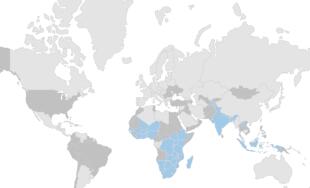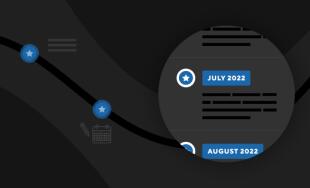Last week, Lenny & I had the pleasure of attending the High 5 conference in Raleigh. Gatherings like these are usually focused on either design or marketing but High 5 focuses on both and the conference badges opened to this quotation attributed to Von R. Glitschka:
“Marketing without design is lifeless, and design without marketing is mute.”
Overall, the theme of the workshops and plenary sessions was that it doesn’t matter how good one's work is if nobody knows about it. The marketer’s job is to communicate the value and promote the virtues of the great work that designers do. So it’s easy to see that they go hand-in-hand and High 5 addresses the intersection of the two.
Show Your Work
Like a lot of web makers, I spend more time focused on the practice and technique of web design than I do about actually getting it in front of people, so I made sure to attend some of the workshops on marketing. Specifically, I wanted to understand better the gradual engagement process of how the content we publish online — articles, diagrams, guides, videos, tutorials — helps brings visitors who become leads that convert into customers.
By far my favorite marketing workshop of the conference was called Solving Your Content Crisis, led by Chris Moody of Oracle. At the heart of what he presented is that teaching sells: prospective buyers want to make informed purchasing decisions and are looking to be educated. As a seller of goods or services — and this applies to NMC as much as to our clients — we do our customers a service by providing expertise. In other words, the best teachers win online.
In practice, we sell-by-teaching when we write guides that answer potential customer questions. But writing compelling content often is hard work! Surely there must be an easier way!? His workshop provided terrific suggestions for exactly that:
You’re still relying on whitepapers to drive all your leads. Lots of people are. Unfortunately, you’re probably missing the boat on the easiest types of content for converting customers. In this session, Chris Moody will explain the importance of content marketing broken down into three sections – low, medium and high effort content. You’ll see real examples, real conversion data and walk away knowing that you need to harness the power of user generated content when you’re back in the office.
What I Learned About (Content) Marketing
If you’re not familiar with content marketing, here’s a handy layman’s definition:
“Content marketing is a way for a business owner to educate your customers and potential customers about your products and services. The goal is to offer tips, help, and education about anything that can be helpful to a customer. This kind of information can be shared in the form of blog, white paper, webinar, video or social post. The opportunities are endless."
I’m no SEO expert (I leave that to Alex & Claire) but I understand that it works like this:
- People find your website online when you rank highly for the search terms they used
- You rank higher when you’re publishing useful content, often
- The higher you rank, the more people will click through
- You attract an engaged visitor looking for your services at that exact moment
- ... Profit
SEO at its heart is about what you can do to improve your organic placement. And apart from lean, semantic, well-structured HTML code — something not really in your control, unless you’re a web developer — the most important thing for to optimize that placement is the frequency, diversity, & utility of the content published on a site (sometimes called the 3 V’s: volume, variety, & value). You write and publish useful stuff, people share and link to it, Google puts that useful content front and center. Straightforward, right?
Content Marketing Isn’t Rocket Science
But that doesn’t make it easy. The workshop facilitator, Chris, asked how many in the audience were responsible for writing content for their company’s site and most hands went up. He followed up by asking how many had a hard time thinking of things to write about and the same hands went up. More than anything, the sentiment of participants was “I know that generating content is important but I’m not sure what to write about it”. Chris wanted to show us how to generate ideas easily and make sure we didn’t miss out on the easiest kind of content to publish.
His main takeaways from the workshop:
- All online marketing is content marketing.
- Teaching is selling and the best teachers win.
- You’re already writing a lot of words, you’re just not using them.
All Online Marketing is Content Marketing
He encouraged us to think of the content we write as the central part of our marketing strategy — that thinking of websites more as magazines than brochures will provide a mucher higher return than any other kind of conventional outbound marketing we’re used to like ads and fliers. He described three categories of typical content:
- High effort: traditional blog, tutorials, buyer’s guides, short videos
- Medium effort: FAQs, Q&A articles, interviews, newsletters
- Low effort: user-generated content, social media, press releases
Many companies at least acknowledge the importance of a blog. But in-depth, high-effort content is difficult to keep up with and in fact it’s the medium category, the Q&A kind of stuff, that converts like crazy (compared to the effort that goes into producing it).
The best example of a successful medium-effort content strategy he gave was Bass Pro Shops: you know, those Walmart-sized outdoor provision companies you see off the highway. It’s safe to say that the main audience is not especially tech savvy — they’re more likely to field-dress a 700-lb. adult buck than upgrade to the latest version of Internet Explorer — but that didn’t stop them from doing all they good to attract inbound search traffic. The Bass Pro Blog site, particularly their “Ask an Expert” section, does a ton of traffic and together with their 1-Source News & Tips site feature, they have a focused, consistent, and effective content marketing strategy.
Chris has worked with them and said they’re killing it online. I mean, if you’re looking for the best knot for tying two fishing lines together, there’s a good chance you’ll find the answer here. Just 150 words but laser-focused! These aren’t hard to write every day and pretty soon, you’ve got a whole library of useful searchable content. And this works for more than text. Using his own company site as an example, Chris explained how they hired a film crew for 2 hours one day and simply asked his colleagues to answer the same ones on film. They generated a dozen or so videos, uploaded them to YouTube, and embedded them on the company site. The result? The math is a little fuzzy but they measured something around $500,000 in new revenue. Just from people who searched online, found the videos, and contacted them.
Teaching is Selling & the Best Teachers Win
Anecdote from the workshop: “How many of you bought a car in the last 5 years? And how many of you did so without reading a single thing about the car or seeking advice from with friends and family?” That included me and it’s safe to say every one of us in the room did our homework. Motivated customers want to know about that they’re making a good product decision.
It was through 37Signals that I first learned about this idea — that teaching is selling — from their book Getting Real. But I’m glad the workshop reminded me because I’d forgotten how successful it really is. Two of the best examples I can think of are from the Signal Vs. Noise blog:
- Selling gear and teaching about bikes at Rivendell
- Saddleback Leather tells its story and promotes through education
Matt Linderman wrote both and does a much better job than I could of describing how effective education can be in selling online, so I’ll just refer you to the blog posts above. But if you haven’t seen Saddleback irreverent and satirical “How to Knock off a Saddleback Briefcase”, you’re missing a masterpiece of modern viral content marketing.
You’re Already Writing a Lot of Words: Use Them!
One of the concerns Chris addressed in the workshop was the difficulty in coming up with ideas for what to write about. He used the occasion to walk us through a LinkedIn article he wrote with practical tips for what to do if you’re stuck:
- Brainstorm with your entire staff on questions they hear every day
- Interview your colleagues & partners
- Turn your email into content
- Interview your customers
- Host your first company write-a-thon
In particular, he combined an earlier point about the short, medium-effort Question-and-Answer posts like Bass Pro Shops uses with email support that many companies engage with every day. That is, we’re already answering a ton of our customers questions already — often the same ones every day, over and over again, through support emails and proposals that we write to win projects. His suggestion: mine the last month of communication with clients and customers and turn the recurring themes into short, searchable Q&A blog posts. These convert extremely well (“think WebMD”, he said). You've already written it and it's useful. Why not put it on your website?
In addition, when you do write up lengthy articles that necessarily review some topics only briefly, you can revisit those topics in more detail later -- and in different contexts. We've been doing this for years at NMC but I hadn't thought of it in these terms until Chris mentioned it at the workshop. For example, recently I wrote an article about web design trends to watch out for in 2015. One of them, the rise of animation, I discussed only briefly but then wrote about in a separate piece in more depth. It's easier to repurpose an existing article than it is to come up with new ideas and by cross-linking posts, you introduce evergreen content to new audiences. (Kind of like how I'm doing right now, actually.) Moreover, another way to extend the life of your content is to repurpose it for different contexts: an article can become a slideshow which can become a newsletter which becomes a series of tweets.
Recap & Further Reading
Coming from a design and development background, attending a workshop like this was revelatory. It's really not a challenge to answer coming questions that our clients & customers will have -- they're looking to be informed and much of the domain knowledge necessary is readily at a professional's fingertips. Writing about our work -- and how our products & services make someone's life better -- is what we do all the time anyway. Content marketing means being deliberate about capturing that information and making it easy to find and read online.
The workshop concluded with the central aim of content marketing: "Tell me about someone like me, with a similar problem, and how you solved it." Can't ask for clearer guidance than that!
If you'd like to read more, be sure to check out Google's 2011 research study “Zero Moment of Truth”. The workshop was the first I'd heard of it and we didn't spend a lot of time on it, but in brief, it's full of great insight -- direct from Google's data -- about the psychology of shopping decisions that people make online:
“When consumers hear about a product today, their first reaction is ‘Let me search online for it.’ And so they go on a journey of discovery: about a product, a service, an issue, an opportunity. Today you are not behind your competition. You are not behind the technology. You are behind your consumer.”





Leave the first comment